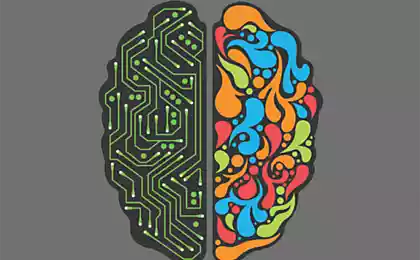214
5 Ways to Increase Reading Speed
According to Google, there are more than 130 million books in the world today. Not all of them really deserve attention, but human life is not enough to read only masterpieces of world literature, not to mention scientific, educational and other printed materials. Those who want to read more, learn speed reading. We have collected 5 exercises and programs that will help you learn how to swallow books in a day.
Development of peripheral vision One of the main tools of speed reading is peripheral, or lateral vision. It is carried out by peripheral areas of the retina and allows you to see and perceive a word or even a whole line instead of a few letters.
The classic way to train peripheral vision is to work with the Schulte table. Such a table is a field divided into 25 squares: five horizontally and five vertically. In each square, a number is inscribed, in total - from 1 to 25, in random order. The task of the student is to consistently find all the numbers in ascending or decreasing, while looking exclusively at the central square.

© Adam deNeige
The Schulte table can be printed on paper, but today there are dynamic online generators and downloadable computer and mobile training, including with a built-in timer. Those who use advanced speed reading programs are advised to “warm up” with the Schulte table before training. If desired, you can switch from 5×5 black and white tables to more complex versions: for example, with colored fields.
Suppression of subvocalization Another of the cornerstone principles of speed reading is the rejection of subvocalization: the pronunciation of words in the head and the micro-movement of the tongue and lips. A person is able to say an average of no more than 180 words per minute – and it is no coincidence that this is the maximum amount for ordinary reading. However, when the speed of perception of the text increases, it becomes more difficult to pronounce words, and subvocalization begins to interfere with the development of a new skill.
There are several simple exercises to suppress mental pronunciation. For example, while reading, you can press your tongue against the sky, clasp the tip of a pencil with your teeth, or even just put your finger to your lips, as if telling yourself: “Hush up.” There are also techniques in which the utterance of the words “broken” chaotic tapping, the sound of a metronome or music.
No regression Speed reading regressions refer to returns to parts of the text that have already been read. They occur when the reader is distracted by extraneous thoughts, or if the speed of information acquisition is too great for the brain to be able to perceive all the information.
To cope with regressions helps, in particular, the training program Best Reader. It is based on the dynamic highlighting of parts of the text on the page in black. It is difficult for human eyes to make orderly movements without observing anything, and this feature allows you to better focus on the desired fragments.
When reading an ordinary book or document on the screen of an electronic device, you can also use a simple technique that we all know since preschool: lead the page with your finger. Getting rid of regressions helps and understanding that further text often makes it possible to fill all the short information gaps that arose in the process of reading.
Concentration Reading fast requires high concentration. To develop it and not read texts superficially, there are several exercises. For example, you can use a sheet on which the names of colors will be printed in color, but so as to confuse the reader. The word “yellow” will be written in red letters, the word “red” in blue, etc. For training, you need to name the color of the ink, not the word that is written on the sheet, and at first it is quite difficult to do this.
For another exercise, only a clean sheet of paper and a pen will be needed. You need to focus your attention on something and not be distracted by extraneous thoughts for two or three minutes. Every time extraneous thoughts arise, you need to make a note on the sheet. Over time, such marks should become less, and after they disappear altogether.
You can also train concentration while reading: just count words in the text. It is important to make calculations exclusively in the mind, without helping yourself with your fingers, tapping your leg, etc. After two or three minutes, you need to stop and check yourself, counting the words without reading them. At first, the first result will differ from the second, but with regular training, the differences between them will quickly become minimal.
Reading whole words The Spritz app is also aimed at developing peripheral vision. For training, only one line is used here, on which words with a red letter in the middle appear at different speeds. Thus, you can learn to perceive words, not reading them from beginning to end, but all at once. This allows you to save up to 80% of the time that normally takes on eye movements, and increase reading speed to 500-1000 words per minute.
For those who just got a new job: 14 tips
How to pay less for water, gas and electricity
On the official website of the application there is a demo version of Spritz, including in Russian. You can choose the speed from 250 to 600 words per minute and other languages: English, German, Spanish and French. In the future, the developers plan to create not only a version for websites and smartphones, but also an option for use within the interface of electronic glasses, smart watches and other compact devices, because the application requires only one line to work. published
Author: Natalia Kienya
Source: theoryandpractice.ru/posts/8624--skorochtenie
Development of peripheral vision One of the main tools of speed reading is peripheral, or lateral vision. It is carried out by peripheral areas of the retina and allows you to see and perceive a word or even a whole line instead of a few letters.
The classic way to train peripheral vision is to work with the Schulte table. Such a table is a field divided into 25 squares: five horizontally and five vertically. In each square, a number is inscribed, in total - from 1 to 25, in random order. The task of the student is to consistently find all the numbers in ascending or decreasing, while looking exclusively at the central square.

© Adam deNeige
The Schulte table can be printed on paper, but today there are dynamic online generators and downloadable computer and mobile training, including with a built-in timer. Those who use advanced speed reading programs are advised to “warm up” with the Schulte table before training. If desired, you can switch from 5×5 black and white tables to more complex versions: for example, with colored fields.
Suppression of subvocalization Another of the cornerstone principles of speed reading is the rejection of subvocalization: the pronunciation of words in the head and the micro-movement of the tongue and lips. A person is able to say an average of no more than 180 words per minute – and it is no coincidence that this is the maximum amount for ordinary reading. However, when the speed of perception of the text increases, it becomes more difficult to pronounce words, and subvocalization begins to interfere with the development of a new skill.
There are several simple exercises to suppress mental pronunciation. For example, while reading, you can press your tongue against the sky, clasp the tip of a pencil with your teeth, or even just put your finger to your lips, as if telling yourself: “Hush up.” There are also techniques in which the utterance of the words “broken” chaotic tapping, the sound of a metronome or music.
No regression Speed reading regressions refer to returns to parts of the text that have already been read. They occur when the reader is distracted by extraneous thoughts, or if the speed of information acquisition is too great for the brain to be able to perceive all the information.
To cope with regressions helps, in particular, the training program Best Reader. It is based on the dynamic highlighting of parts of the text on the page in black. It is difficult for human eyes to make orderly movements without observing anything, and this feature allows you to better focus on the desired fragments.
When reading an ordinary book or document on the screen of an electronic device, you can also use a simple technique that we all know since preschool: lead the page with your finger. Getting rid of regressions helps and understanding that further text often makes it possible to fill all the short information gaps that arose in the process of reading.
Concentration Reading fast requires high concentration. To develop it and not read texts superficially, there are several exercises. For example, you can use a sheet on which the names of colors will be printed in color, but so as to confuse the reader. The word “yellow” will be written in red letters, the word “red” in blue, etc. For training, you need to name the color of the ink, not the word that is written on the sheet, and at first it is quite difficult to do this.
For another exercise, only a clean sheet of paper and a pen will be needed. You need to focus your attention on something and not be distracted by extraneous thoughts for two or three minutes. Every time extraneous thoughts arise, you need to make a note on the sheet. Over time, such marks should become less, and after they disappear altogether.
You can also train concentration while reading: just count words in the text. It is important to make calculations exclusively in the mind, without helping yourself with your fingers, tapping your leg, etc. After two or three minutes, you need to stop and check yourself, counting the words without reading them. At first, the first result will differ from the second, but with regular training, the differences between them will quickly become minimal.
Reading whole words The Spritz app is also aimed at developing peripheral vision. For training, only one line is used here, on which words with a red letter in the middle appear at different speeds. Thus, you can learn to perceive words, not reading them from beginning to end, but all at once. This allows you to save up to 80% of the time that normally takes on eye movements, and increase reading speed to 500-1000 words per minute.
For those who just got a new job: 14 tips
How to pay less for water, gas and electricity
On the official website of the application there is a demo version of Spritz, including in Russian. You can choose the speed from 250 to 600 words per minute and other languages: English, German, Spanish and French. In the future, the developers plan to create not only a version for websites and smartphones, but also an option for use within the interface of electronic glasses, smart watches and other compact devices, because the application requires only one line to work. published
Author: Natalia Kienya
Source: theoryandpractice.ru/posts/8624--skorochtenie
Hidden psychological reasons for excess weight
A simple pharmaceutical remedy for wrinkles that works!























